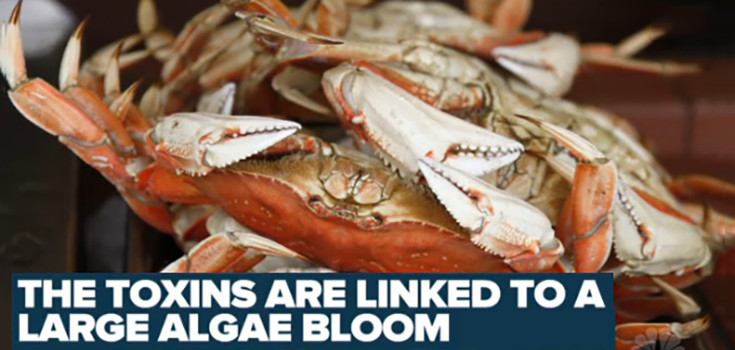Toxic Algae Bloom Delays California Crabbing Season
Toxic Algae Bloom Delays California Crabbing Season
Crabs left with dangerous neurotoxins
Officials in California have decided to delay the start of crab season due to a spike in toxins that may make the creatures dangerous for human consumption.
Officials in California have decided to delay the start of crab season due to a spike in toxins that may make the creatures dangerous for human consumption. [1]
“Due to the detection of dangerous levels of domoic acid,” Dungeness and rock crabs caught in waters between the Oregon borders and the southern Santa Barbara County line pose a “significant risk to the public if consumed,” the California Department of Public Health (DPH) said in a release. [2]
Traditionally, Saturday would be the first day that recreational fishermen would take to the shores to start pulling in crabs, but they’ll have to wait now that authorities have located a massive bloom of coastal algae that produces a neurotoxin called domoic acid. The commercial crabbing season had been slated to begin Nov. 15.
“It’s going to be devastating” for the crabbers whose livelihood depends on this crucial time of the year, said Mike Dvorak, captain of the High Seas, a vessel that collects some 20,000 pounds of varied seafood in a single haul. Commercial crabbing is a $60 million a year industry. Halting the crab season would have a lesser impact on boat owners, he says. “Those who aren’t boat owners will say it’s a disaster. They won’t know what to tell their families.” [3]
But health officials say the safety and wellbeing of residents is their first priority.
The naturally occurring toxin is produced by “some species of the marine diatom Pseudo-nitzschia,” according to the state Department of Fish and Wildlife. The Pseudo-nitzschia bloom is especially large this year thanks to warmer water temperatures associated with the El Ninoevent. The phenomenon has raised the water temperatures of the Pacific by up to 9 degrees along portions of the California coast.
Crabs and other marine animals filter their food through seawater and may accumulate domoic acid. The colorless, odorless toxins don’t appear to harm sea creatures, but people who eat them can be poisoned. Neither cleaning nor cooking these foods will rid them the toxins.
Domoic acid poisoning symptoms typically strike 30 minutes to 24 hours after eating affected seafood, says the California DPH. Individuals poisoned by the toxins may suffer vomiting, diarrhea, stomach cramps, headache, dizziness and confusion and, rarely, difficulty breathing, seizures, coma and death. Some survivors have been known to suffer permanent short-term memory loss. [4]
Public health officials say Dungeness crabs sold in restaurants and supermarkets should be safe. “There’s a lot of areas around the country, both East and West Coast, that you can get crab from,” said Patrick Kennelly, chief of the foods-safety section at the state DPH. “They may be sourcing from areas outside of the current area of concern. … If they can’t tell you where it came from, then you probably want to avoid it, just out of an abundance of caution.”
The unprecedented size of the algae bloom also prompted the California Fish and Game Commission to shut down recreational rock crab fishing, which typically runs year-round. [5]
Algae conditions also prompted health warnings earlier this year about toxins in several types of seafood, including certain anchovies, mussels and sardines on California’s Central Coast, as well as about a variety of shellfish found in Oregon and Washington. The crab advisories, however, only apply to California and southern Oregon.
No one knows when the algae bloom will get smaller, or when the crabs will be safe to eat again. It could take a lot longer than people think.
“Historically, we see blooms during and after the El Niño,” Kudela said. “So it’s quite possible that next year will be another big bloom year and possibly just as toxic or more toxic. So, at that point, three years in a row, it starts to become the new normal.” [6]
“When it’s clear, we’ll get the fisheries open as soon as possible,” said Sonke Mastrup, the executive director of the commission, told the Sacramento Bee.
| About Julie Fidler: | |
| Julie Fidler is a freelance writer, legal blogger, and the author of Adventures in Holy Matrimony: For Better or the Absolute Worst. She lives in Pennsylvania with her husband and two ridiculously spoiled cats. She occasionally pontificates onher blog. | |
Other Popular Stories:

Post a Comment